2021-09-02 - Nº 331
Editorial
Esta é a Newsletter Nº 331 que se apresenta com o mesmo formato que as anteriores. Se gostar da Newsletter partilhe-a!
Todas as Newsletters encontram-se indexadas no link.
Esta Newsletter tem os seguintes tópicos:
Faz hoje anos que nascia, em 1853, o químico físico russo-alemão Wilhelm Ostwald. Ele conseguiu quase sozinho organizar a química física num ramo quase independente da química. Ganhou o Prémio Nobel da Química em 1909 pelo seu trabalho sobre catálise, equilíbrio químico, e velocidades de reacção.
Faz também hoje anos que nascia, em 1877, o químico e físico inglês Frederick Soddy. Ele recebeu o Prémio Nobel da Química em 1921 por investigar as substâncias radioactivas. Ele sugeriu que diferentes elementos produzidos em diferentes transformações radioactivas eram capazes de ocupar o mesmo lugar na Tabela Periódica, e a 18 de Fevereiro de 1913 ele nomeou tais espécies "isótopos" a partir de palavras gregas que significavam "mesmo lugar". Ele é creditado, juntamente com outros, com a descoberta do elemento protactinium em 1917.
Faz igualmente hoje anos que nascia, em 1878, o matemático francês Maurice René Fréchet. Ele ficou conhecido sobretudo pela sua contribuição para a análise real. É creditado por ser o fundador da teoria dos espaços abstractos, que generalizou a definição matemática tradicional do espaço como locus para a comparação de figuras; em termos de Fréchet, o espaço é definido como um conjunto de pontos e o conjunto de relações. Na sua dissertação de 1906, investigou os funcionais sobre um espaço métrico e formulou a noção abstracta de compacidade. Em 1907, descobriu um teorema de representação integral dos funcionais no espaço das funções integráveis quadráticas de Lebesgue. Também fez importantes contribuições para a estatística, probabilidade e cálculo.
Por fim, faz hoje anos que nascia, em 1923, o matemático francês René Thom. Ele recebeu a Medalha Fields em 1958 pelo seu trabalho em topologia, em particular em classes características, teoria do cobordismo e o teorema da transversalidade de Thom. Thom é também conhecido pelo seu trabalho posterior no desenvolvimento da teoria da catástrofe (1972), um tratamento matemático de acção contínua produzindo um resultado descontínuo. A teoria de Thom é uma tentativa de descrever, de uma forma que é impossível utilizando o cálculo diferencial, aquelas situações em que forças em mudança gradual conduzem às chamadas catástrofes, ou mudanças abruptas. A teoria tem aplicação generalizada nas ciências físicas e biológicas e nas ciências sociais, mas acabou por cair em desuso.
Em 1752 este foi o ultimo dia do calendário juliano para o império Britânico. Nesse ano, saltaram os dias 3 a 13 e adoptaram o calendário gregoriano. Onze dias foram saltados para adoptar o calendário gregoriano, concebido para realinhar o calendário com equinócios. Assim, o dia seguinte foi 14 de Setembro. Durante mais de um século e meio antes, na sequência do decreto do Papa Gregório XIII, Itália, e três outros países católicos (Espanha, Portugal e Polónia) utilizaram o calendário juliano pela última vez em 4 de Outubro de 1582. Seguiu-se a França, terminando a utilização do calendário juliano em 9 de Dezembro de 1582. A Rússia não mudou até ao início do século XX: 31 de Janeiro de 1918 foi a última data Juliana, seguida no dia seguinte por 14 de Fevereiro de 1918. Partes da China mudaram em 1912, mas a revolução comunista de 1949 estabeleceu a utilização do calendário gregoriano em toda a China.
Em 1969 abria a primeira caixa automática (ATM) da América, distribuindo dinheiro aos clientes no Chemical Bank em Rockville Centre, Nova Iorque. As caixas automáticas passaram a revolucionar a indústria bancária, eliminando a necessidade de visitar um banco para realizar transacções financeiras básicas. Na década de 1980, estas máquinas de dinheiro tinham-se tornado amplamente populares e lidavam com muitas das funções anteriormente desempenhadas por caixas humanos, tais como depósitos de cheques e transferências de dinheiro entre contas. Hoje em dia, as caixas automáticas são tão indispensáveis para a maioria das pessoas como os telemóveis e o correio electrónico.
Nesta semana que passou foi lançado o Linux Kernel 5.14. De entre as novidades destaca-se o suporte de agendamento de core, um novo controlador prioritário de I/O para gerir a prioridade dos pedidos de I/O do tipo block, um novo comando ioctl() para melhorar o journaling nos sistemas de ficheiros EXT4. Esta versão inclui ainda suporte total do kernel para o Raspberry Pi 400. Finalmente, há um esforço contínuo para adicionar suporte Linux para tecnologias emergentes e novas, incluindo USB 4, processador Intel 'Alder Lake', placas gráficas AMD Beige Goby & Yellow Carp.
Na Newsletter desta semana apresentamos diversas noticias, artigos científicos, projetos de maker assim como alguns videos interessantes.
 João Alves ([email protected])
João Alves ([email protected])
O conteúdo da Newsletter encontra-se sob a licença  Creative Commons Attribution-NonCommercial-ShareAlike 4.0 International License.
Creative Commons Attribution-NonCommercial-ShareAlike 4.0 International License.
Novidades da Semana

Linux Kernel 5.14 Released, This is What’s New
"Announcing the latest kernel’s arrival on the Linux Kernel mailing list Linux founder Linus Torvalds couldn’t resist acknowledging the attention his ‘hobby’ project has received for its 30th anniversary recently, remarking: “I realize you must all still be busy with all the galas and fancy balls and all the other 30th anniversary events, but at some point you must be getting tired of the constant glitz, the fireworks, and the champagne. That ball gown or tailcoat isn’t the most comfortable thing, either. The celebrations will go on for a few more weeks yet, but you all may just need a breather from them.” Quite so, Linus! Quite so! So what goodies await us in this kernel uplift? Let’s take a look… Linux 5.14 New Features Linux 5.14 features (as always) an avalanche of improvements big and small, new capabilities, and enhanced hardware support." [...]
Outras Notícias
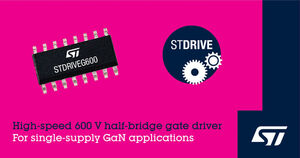
Single-chip GaN Gate Driver from STMicroelectronics Boosts Speed, Flexibility, and Integration in Industrial and Home Automation
"STMicroelectronics’ STDRIVEG600 half-bridge gate driver has high current output and 45ns propagation delay, closely matched between high-side and low-side outputs, to handle high-frequency switching of GaN enhancement-mode FETs. Also suitable for driving N-channel silicon MOSFETs at up to 20V, the STDRIVEG600 allows the flexibility to apply up to 6V gate-source voltage (VGS) on GaN devices to ensure low Rds(on). In addition, there is an integrated bootstrap circuit that helps minimize the bill of materials and simplify board layout. This circuit uses a synchronous MOSFET that lets the bootstrap voltage reach the logic supply voltage, VCC, allowing the driver to operate from a single supply without a low-dropout regulator (LDO). With dV/dt immunity of ±200V/ns, the STDRIVEG600 ensures dependable gate control in challenging electrical environments. The logic inputs are CMOS/TTL compatible down to 3.3V for easy interfacing with a host microcontroller or DSP." [...]

Renesas Expands ProXO Oscillator Portfolio for High-Performance Communications, and Data Center Applications
"ProXO+ Portfolio Delivers ±3ppm Frequency Stability with Programmable Frequencies up to 2.1GHz and 135fs Phase Jitter Performance. enesas Electronics Corporation (TSE:6723), a premier supplier of advanced semiconductor solutions, today expanded its robust timing solutions portfolio with the ProXO+ family of compact, ultra-low noise, temperature-controlled clock oscillators. The high-accuracy, high-frequency, differential oscillators are best suited for fiber optic transceiver modules, accelerator cards, smart NIC cards, and networking equipment applications. “The ProXO+ family delivers on all counts, offering tight frequency stability, great jitter performance, and high output frequency, which are critical features for communications, cloud and compute markets,” said Bobby Matinpour, Vice President of Timing Products at Renesas. “The ProXO+ family’s high level of programmability also enables the use of a single device for numerous designs, simplifying the BOM, sourcing, and inventory management.” Key Features of the ProXO+ Family - Frequency stability ±3 ppm from -40C to +85C temperature range - Programmable frequencies up to 2.1 GHz - 135fs typical phase jitter (12 KHz-20 MHz) - 3.2 x 2.5 mm in an 8-pin plastic package In addition to the new ProXO+ family, Renesas is expanding the popular original ProXO XF 2.5 x 2.0 mm device to include two new industry-standard 3.2 x 2.5 mm and 5.0 x 3.2 mm plastic packages. The ProXO+ family can be combined with Renesas’ complementary clock buffers, power, and microcontroller offerings to create comprehensive solutions for a variety of applications, such as the Xilinx Kintex-7 Power and Timing, the CC-Link IE TSN, and the System on Module (SoM) Solution with RZ/G2E." [...]
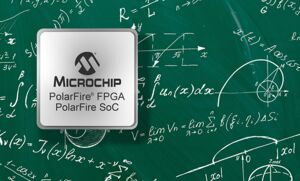
Smart High Level Synthesis (HLS) Tool Suite Enables C++ Based Algorithm Development Using Microchip’s PolarFire® FPGA Platform
"Enhances Accessibility to PolarFire FPGAs for Hardware Acceleration in Edge Compute Systems. The need to combine performance with low power consumption in edge compute applications has driven demand for Field Programmable Gate Arrays (FPGAs) to be used as power-efficient accelerators while also providing flexibility and speeding time to market. However, a large majority of edge compute, computer vision and industrial control algorithms are developed natively in C++ by developers with little or no knowledge of underlying FPGA hardware. To enable this important development community, Microchip Technology Inc. (Nasdaq: MCHP) has added an HLS design workflow. called SmartHLS, to its PolarFire FPGA families that greatly enhances productivity and ease of design by allowing C++ algorithms to be directly translated to FPGA-optimized Register Transfer Level (RTL) code. “SmartHLS enhances our Libero® SoC design tool suite and makes the vast benefits of our award-winning mid-range PolarFire and PolarFire SoC platforms accessible to a diverse community of algorithm developers without them having to become FPGA hardware experts,” said Bruce Weyer, vice president of Microchip’s FPGA business unit." [...]

Samsung Brings Advanced Ultra-Fine Pixel Technologies to New Mobile Image Sensors
"Samsung Electronics, a world leader in advanced semiconductor technology, today introduced the ISOCELL HP1, the industry’s first 200-megapixel (MP) image sensor with 0.64μm pixels, and ISOCELL GN5, the first image sensor to adopt all-directional focusing Dual Pixel Pro technology with two photodiodes in a single 1.0μm pixel. “Samsung has been pioneering ultrafine pixel technologies that are taking high-resolution image sensors to the next level,” said Duckhyun Chang, executive vice president of sensor business at Samsung Electronics. “With the ISOCELL HP1 that is breaking barriers and ISOCELL GN5 bringing ultrafast auto focus, Samsung will continue to lead the trend for next-generation mobile imaging technologies.” ISOCELL HP1: Capture the World in Breathtaking 200MP and Crystal Sharp 8K Video The ISOCELL HP1 is the industry’s first mobile image sensor to support 200MP. Based on Samsung’s most advanced 0.64μm-sized pixels, the ISOCELL HP1 brings such ultrahigh resolution in a small package that fits comfortably in today’s handheld devices. With the ISOCELL HP1, pictures hold an astonishing amount of detail that helps the image stay sharp even when cropped or resized. For ultimate low-light photography, the ISOCELL HP1 features an all-new ChameleonCell technology, a pixel-binning technology that uses a two-by-two, four-by-four or full pixel layout depending on the environment." [...]

Renesas and eProsima Simplify Development Of Professional Robotics Applications On RA MCUs With micro-ROS Development Framework
"Agreement Facilitates Adoption of Robotics in Industrial and IoT Sectors; EK-RA6M5 Evaluation Kit Now Official Supported micro-ROS Development Board. Renesas Electronics Corporation (TSE:6723), a premier supplier of advanced semiconductor solutions, and eProsima, an SME company specialized in middleware solutions, today announced that the Renesas EK-RA6M5 Evaluation Kit for RA MCUs is the official supported hardware platform of the micro-ROS development framework. micro-ROS is the industry’s robotics operating system for MCUs. Renesas teamed with eProsima, the main developer of the micro-ROS framework, to port micro-ROS into the RA MCUs, easing development of professional robotics applications for IoT and industrial systems. The micro-ROS framework allows a standardized integration of MCUs into the Robot Operating System (ROS) 2 data space. It provides an established application development framework based on standard communication middleware to the embedded world." [...]

Windows 11 available on October 5
"Today, we are thrilled to announce Windows 11 will start to become available on October 5, 2021. On this day, the free upgrade to Windows 11 will begin rolling out to eligible Windows 10 PCs and PCs that come pre-loaded with Windows 11 will start to become available for purchase. A new Windows experience, Windows 11 is designed to bring you closer to what you love. As the PC continues to play a more central role in our lives than ever before — Windows 11 is ready to empower your productivity and inspire your creativity. Here are 11 highlights of this release - The new design and sounds are modern, fresh, clean and beautiful, bringing you a sense of calm and ease. - With Start, we’ve put you and your content at the center." [...]

Western Digital Reimagines The Hard Drive
"At the company’s HDD Reimagine event today, Western Digital Corp. (NASDAQ: WDC) introduced a new flash-enhanced drive architecture that breaks traditional boundaries of storage. Building on the company’s unique ability to innovate with HDD and flash, the new storage architecture with OptiNAND™ technology optimizes and integrates HDDs with iNAND® embedded flash drives. This gives customers – like hyperscale cloud, CSPs, enterprises, smart video surveillance partners, NAS suppliers and more – a solution to meet the exponential growth in data creation by delivering the capacity, performance and reliability needed to store vast amounts of data today and well into the future. Leveraging industry-first technologies including triple-stage actuator (TSA) and HelioSeal® technology, the first products featuring the new drive architecture will deliver an unsurpassed 2.2TB per platter, extending capacities gains on proven ePMR technology. Setting a new industry milestone, Western Digital has shipped samples of new nine-disk, 20TB ePMR flash-enhanced drives with OptiNAND technology to select customers. “Western Digital has a history of hard drive architecture innovations, such as when HGST (now part of Western Digital) first hermetically sealed and shipped helium HDDs in 2013,” said Ed Burns, research director for hard disk drives at IDC." [...]

Astra rocket fails to reach space during test launch for US military
"The third try wasn't the charm for Astra. The California Bay Area startup attempted its third orbital test flight today (Aug. 28), sending its two-stage Launch Vehicle 0006 skyward from the Pacific Spaceport Complex on Alaska's Kodiak Island at 6:35 p.m. EDT (2235 GMT). The rocket suffered an anomaly about 2.5 minutes after liftoff, however, and the flight was terminated. Something appeared to be wrong from the beginning, as Launch Vehicle 0006 lurched sideways at the moment of liftoff rather than rise smoothly off the pad. But the rocket recovered and soared high into the Alaska sky, reaching an altitude of about 20.5 miles (33 kilometers) before shutting down, according to real-time data Astra provided during a webcast of the launch. The mission was terminated right around "max q," the point when the mechanical stresses on a rocket are highest." [...]
The Semiconductor Heist Of The Century | Arm China Has Gone Completely Rogue, Operating As An Independent Company With Inhouse IP/R&D
"Arm is widely regarded as the most important semiconductor IP firm. Their IP ships in billions of new chips every year from phones, cars, microcontrollers, Amazon servers, and even Intel’s latest IPU. Originally it was a British owned and headquartered company, but SoftBank acquired the firm in 2016. They proceeded to plow money into Arm Limited to develop deep pushes into the internet of things, automotive, and server. Part of their push was also to go hard into China and become the dominant CPU supplier in all segments of the market. As part of the emphasis on the Chinese market, SoftBank succumbed to pressure and formed a joint venture." [...]

FAA grounds Virgin Galactic’s spacecraft during investigation of Branson flight issues
"The Federal Aviation Administration grounded Virgin Galactic on Thursday, as the federal regulator investigates the company’s previous spaceflight that carried founder Richard Branson. “Virgin Galactic may not return the SpaceShipTwo vehicle to flight until the FAA approves the final mishap investigation report or determines the issues related to the mishap do not affect public safety,” the FAA said in a statement to CNBC. “The FAA is responsible for protecting the public during commercial space transportation launch and reentry operations. The FAA is overseeing the Virgin Galactic investigation of its July 11 SpaceShipTwo mishap that occurred over Spaceport America, New Mexico. SpaceShipTwo deviated from its Air Traffic Control clearance as it returned to Spaceport America,” the regulator added. Shares of Virgin Galactic, which rose as much as 5% earlier in trading, turned negative and fell more than 5% after the FAA’s announcement." [...]

New AMD Patent Proposes Teleportation to Make Quantum Computing More Efficient
"Based on a multi-SIMD quantum processor architecture A team of researchers with AMD have filed a patent application that looks toward a more efficient and reliable quantum computing architecture, thanks to a conventional multi-SIMD (Single Instruction Multiple Data) approach. According to the application, AMD is researching a system that aims to use quantum teleportation to increase a quantum system's reliability, while simultaneously reducing the number of qubits necessary for a given calculation. The aim is to both alleviate scaling problems and calculation errors stemming from system instability. There are two major hurdles on the road to quantum development and eventual quantum supremacy: scalability and stability. Quantum states are a fickle matter, so sensitive that they can decohere at the slightest provocation -- and a quantum system's sensitivity tends to increase with the presence of more qubits in a given system. The AMD patent, titled "Look Ahead Teleportation for Reliable Computation in Multi-SIMD Quantum Processor," aims to improve quantum stability, scalability, and performance in novel, more efficient ways." [...]

NASA Begins Air Taxi Flight Testing with Joby
"NASA began flight testing Monday with Joby Aviation’s all-electric vertical takeoff and landing (eVTOL) aircraft as part of the agency’s Advanced Air Mobility (AAM) National Campaign. This testing runs through Friday, Sept.10, at Joby’s Electric Flight Base located near Big Sur, California. This is the first time NASA will test an eVTOL aircraft as part of the campaign. In the future, eVTOL aircraft could serve as air taxis for those in cities and surrounding areas around the country, adding another mode of transportation for moving people and goods. NASA’s goal is to collect vehicle performance and acoustic data for use in modeling and simulation of future airspace concepts. This test will help identify gaps in current Federal Aviation Administration regulations and policies to help incorporate AAM aircraft into the National Airspace System." [...]

China eyes ‘ultra-large spacecraft’ spanning miles in US$2.3m crewed mission push
"A mega spacecraft assembled in orbit is among projects that Chinese researchers have been invited to study, as the country expands plans for future space exploration and long-term crewed missions. The National Natural Science Foundation of China has called on scientists to join a five-year project to study the mechanics of an “ultra-large spacecraft spanning kilometres”. “[Such a spacecraft] is a major strategic aerospace equipment for the future use of space resources, exploration of the mysteries of the universe and staying in long-term orbit,” said an outline of the project published by the foundation – a basic research funding agency managed by the Ministry of Science and Technology. That was among 10 proposed research outlines released earlier this month by the foundation’s mathematical and physical sciences department, which will fund five projects capped at 15 million yuan (US$2.3 million) each. According to the published outline, the modular spacecraft would have to be launched multiple times and assembled in space, because it would be too heavy and huge to be launched in one flight. Researchers will be tasked with minimising the weight of the spacecraft to reduce the number of launches and construction costs." [...]
Ciência e Tecnologia

NUS researchers develop brain-inspired memory device that can revolutionise semiconductor design
"Reconfigurable device can simplify semiconductor circuit design and enhance computational power and speed Many electronic devices today are dependent on semiconductor logic circuits based on switches hard-wired to perform predefined logic functions. Physicists from the National University of Singapore (NUS), together with an international team of researchers, have developed a novel molecular memristor, or an electronic memory device, that has exceptional memory reconfigurability. Unlike hard-wired standard circuits, the molecular device can be reconfigured using voltage to embed different computational tasks. The energy-efficient new technology, which is capable of enhanced computational power and speed, can potentially be used in edge computing, as well as handheld devices and applications with limited power resource. “This work is a significant breakthrough in our quest to design low-energy computing. The idea of using multiple switching in a single element draws inspiration from how the brain works and fundamentally reimagines the design strategy of a logic circuit,” said Associate Professor Ariando from the NUS Department of Physics who led the research." [...]
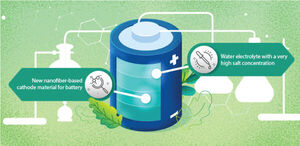
Electric gains in battery performance
"Batteries made from earth-abundant metals show great potential for grid-scale energy storage. A high-performance version of the zinc-ion battery will enable station energy storage that promises to be cheaper, safer and more environmentally friendly than lithium-ion batteries. Until now, zinc-ion batteries have been severely hampered by their rapid degradation during use. Now, a KAUST team has developed a new electrolyte and electrode combination that improved several aspects of zinc-ion battery performance, particularly the stability over multiple charge and discharge cycles. Stationary banks of batteries connected to renewable energy sources, such as solar installations or wind farms, could be key to the transition from the current fossil-fuel powered electricity grid. Unlike batteries for mobile applications, such as laptops or electric cars where battery size and weight are key, stationary batteries can be relatively large and heavy, raising the possibility that alternative rechargeable battery technologies to lithium-ion could be deployed." [...]

Using adversarial attacks to refine molecular energy predictions
"MIT researchers find a new way to quantify the uncertainty in molecular energies predicted by neural networks. Neural networks (NNs) are increasingly being used to predict new materials, the rate and yield of chemical reactions, and drug-target interactions, among others. For these applications, they are orders of magnitude faster than traditional methods such as quantum mechanical simulations. The price for this agility, however, is reliability. Because machine learning models only interpolate, they may fail when used outside the domain of training data. But the part that worried Rafael Gómez-Bombarelli, the Jeffrey Cheah Career Development Professor in the MIT Department of Materials Science and Engineering, and graduate students Daniel Schwalbe-Koda and Aik Rui Tan was that establishing the limits of these machine learning (ML) models is tedious and labor-intensive." [...]

Using Liquid Metal to Turn Motion into Electricity – Even Underwater
"Researchers at North Carolina State University have created a soft and stretchable device that converts movement into electricity and can work in wet environments. “Mechanical energy – such as the kinetic energy of wind, waves, body movement and vibrations from motors – is abundant,” says Michael Dickey, corresponding author of a paper on the work and Camille & Henry Dreyfus Professor of Chemical and Biomolecular Engineering at NC State. “We have created a device that can turn this type of mechanical motion into electricity. And one of its remarkable attributes is that it works perfectly well underwater.” The heart of the energy harvester is a liquid metal alloy of gallium and indium. The alloy is encased in a hydrogel – a soft, elastic polymer swollen with water. The water in the hydrogel contains dissolved salts called ions." [...]

Researchers Realize Measurement Beyond Standard Quantum Limit with Nitrogen-vacancy Centers in Diamond
"Measurement is an important means of human cognition of nature and many measurements are limited by standard quantum limit (SQL). SQL is defined as the measured noise levels set by quantum mechanics. Quantum entanglement can be used to beat SQL and approach an ultimate limit called Heisenberg limit (HL). Sub-SQL measurements have been realized in many systems under extreme conditions and sensors in these systems are not suitable for realistic measurements under ambient conditions. Nitrogen-vacancy (NV) centers in diamond can be utilized as sensors for electron and nuclear magnetic resonance. They can work well in environmental conditions due to the protection of solid crystal lattice." [...]

Testing 1-2: New Laser-Based Microphone Calibration Measures Up
"The NIST demonstration shows the laser method is more accurate and faster than one common type of microphone calibration technique. Researchers at the National Institute of Standards and Technology (NIST) have conducted the first demonstration of a faster and more accurate way to calibrate certain kinds of microphones. The technique, which uses lasers to measure the velocity at which a microphone’s diaphragm vibrates, performs well enough to overtake one of the main calibration methods used at NIST and throughout industry. Someday, a laser-based method could be commercialized to become a completely new way to do extremely sensitive, low-uncertainty calibrations of microphones in the field, in places such as factories and power plants. Potential users of such a commercial system could include organizations that monitor workplace or community noise levels or the condition of machinery via sound. “There’s nothing like this on the market now, not that I’m aware of,” said NIST scientist Randall Wagner." [...]
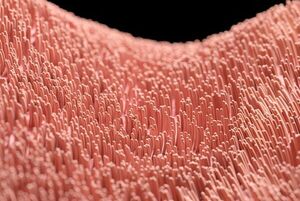
Artificial ultra-tiny ‘hairs’ open up future small-scale applications
"Our researchers have developed a new way to make magnetic artificial so-called cilia comparable in size to real cilia that could be used in future microfluidic devices and sensors. Cilia are tiny hairs used in transport and sensing in the human body. Many scientists are trying to make artificial cilia for applications in microfluidic devices and sensors, but to date, they are much larger than biological cilia. Researchers at Eindhoven University of Technology and EPFL in Switzerland have solved this issue by designing a new way to make magnetic artificial cilia with the same maneuverability and size of biological cilia. In the biological world, the ultimate micro-controllers are cilia. These tiny hairs can be found on the surface of microorganisms and help propel them through liquids." [...]
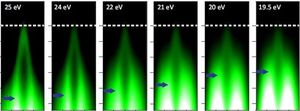
Disorder brings out quantum physical talents
"Quantum effects are most noticeable at extremely low temperatures, which limits their usefulness for technical applications. Thin films of MnSb2Te4, however, show new talents due to a small excess of manganese. Apparently, the resulting disorder provides spectacular properties: The material proves to be a topological insulator and is ferromagnetic up to comparatively high temperatures of 50 Kelvin, measurements at BESSY II show. This makes this class of material suitable for quantum bits, but also for spintronics in general or applications in high-precision metrology. Quantum effects such as the anomalous quantum Hall effect enable sensors of highest sensitivity, are the basis for spintronic components in future information technologies and also for qubits in quantum computers of the future. However, as a rule, the quantum effects relevant for this only show up clearly enough to make use of them at very low temperatures near absolute zero and in special material systems." [...]

Nano ‘camera’ made using molecular glue allows real-time monitoring of chemical reactions
"Researchers have made a tiny camera, held together with ‘molecular glue’ that allows them to observe chemical reactions in real time. The device, made by a team from the University of Cambridge, combines tiny semiconductor nanocrystals called quantum dots and gold nanoparticles using molecular glue called cucurbituril (CB). When added to water with the molecule to be studied, the components self-assemble in seconds into a stable, powerful tool that allows the real-time monitoring of chemical reactions. The camera harvests light within the semiconductors, inducing electron transfer processes like those that occur in photosynthesis, which can be monitored using incorporated gold nanoparticle sensors and spectroscopic techniques. They were able to use the camera to observe chemical species which had been previously theorised but not directly observed. The platform could be used to study a wide range of molecules for a variety of potential applications, such as the improvement of photocatalysis and photovoltaics for renewable energy." [...]

Rice physicists find ‘magnon’ origins in 2D magnet
"Topological feature could prove useful for encoding information in electron spins Rice physicists have confirmed the topological origins of magnons, magnetic features they discovered three years ago in a 2D material that could prove useful for encoding information in the spins of electrons. The discovery, described in a study published online this week in the American Physical Society journal PRX, provides a new understanding of topology-driven spin excitations in materials known as in 2D van der Waals magnets. The materials are of growing interest for spintronics, a movement in the solid-state electronics community toward technologies that use electron spins to encode information for computation, storage and communications. Spin is an intrinsic feature of quantum objects and the spins of electrons play a key role in bringing about magnetism. Rice physicist Pengcheng Dai, co-corresponding author of the PRX study, said inelastic neutron-scattering experiments on the 2D material chromium triiodine confirmed the origin of the topological nature of spin excitations, called magnons, that his group and others discovered in the material in 2018. The group’s latest experiments at Oak Ridge National Laboratory’s (ORNL) Spallation Neutron Source showed “spin-orbit coupling induces asymmetric interactions between spins” of electrons in chromium triiodine, Dai said." [...]

The forecast for Mars? Otherworldly weather predictions
"As scientists prepare for crewed research missions to nearby planets and moons, they’ve identified a need for something beyond rovers and rockets. They need accurate weather forecasts. Without them, any trip to the surface may be one dust storm away from disaster. A new Yale study helps lay the foundation for more accurate, otherworldly forecasts by taking a phenomenon related to Earth’s jet stream and applying it to weather patterns on Mars and Titan, Saturn’s largest moon. The study appears in the journal Nature Astronomy. “I believe the first accurate forecasts of perhaps a few Mars days may be only a decade away,” said lead author J. Michael Battalio, a postdoctoral researcher in Earth and planetary sciences in Yale’s Faculty of Arts and Sciences." [...]
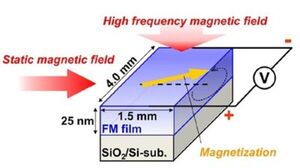
Scientists develop an energy harvesting technology based on ferromagnetic resonance
"Osaka City University succeeds in capturing energy generated through electromotive force from a ferromagnetic metal thin film under ferromagnetic resonance Summary Researchers have succeeded in storing electricity with the voltage generated from ferromagnetic resonance (FMR) using a nanometer-thin magnetic film. Exploring the storage characteristics of the commonly used iron-cobalt and iron-nickel alloy thin films, they found that by controlling the thermal conditions of the thin film to be within FMR excitation range, energy can be stored by all the electromagnetic waves that surround us – including Wi-Fi. Research outline Researchers from the Graduate School of Engineering, Osaka City University have succeeded in storing electricity with the voltage generated from the conversion phenomenon of ferromagnetic resonance (FMR) using an ultra-thin magnetic film of several tens of nanometers. The research was conducted under the leadership of Prof. Eiji Shikoh. “We are interested in efficiently using the Earth’s natural resources to harvest energy,” states the professor, “and capturing the energy from electromagnetic waves that surround us through the electromotive force (EMF) they generate in magnetic films under FMR shows potential as one such way”. Their research was published in the journal AIP Advances." [...]
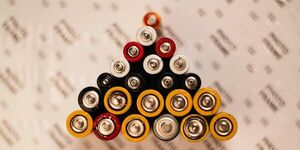
Want Your Lithium Batteries To Last Longer? Try Stretching.
"USC researchers have applied fundamental mechanics to help increase battery storage capacity and lifespan. Batteries are widely used in everyday applications like powering electric vehicles, electronic gadgets and are promising candidates for sustainable energy storage. However, as you’ve likely noticed with daily charging of batteries, their functionality drops off over time. Eventually, we need to replace these batteries, which is not only expensive but also depletes the rare earth elements used in making them. A key factor in battery life reduction is the degradation of a battery’s structural integrity. To discourage structural degradation, a team of researchers from USC Viterbi School of Engineering are hoping to introduce “stretch” into battery materials so they can be cycled repeatedly without structural fatigue." [...]
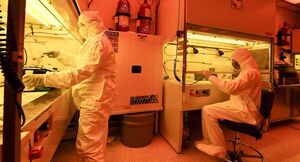
Space Mission Tests NREL Perovskite Solar Cells
"On a clear night, Kaitlyn VanSant will be able to watch her work whiz by. Knowing the success of her project, however, will have to wait until her tiny, temporary addition to the International Space Station returns to Earth. "My family and I have definitely been looking up at night more frequently," said VanSant, who earned her doctorate from the Colorado School of Mines in materials science last year. Now a postdoctoral researcher with NASA, VanSant holds a unique collaborative appointment at the National Renewable Energy Laboratory (NREL). The pairing of NREL and NASA continues a long-standing alliance between solar power and space. Specialized photovoltaic (PV) panels turned to the sun have been used to generate electricity for Mars rovers and space probes, but the manufacturing costs of these high-efficiency solar cells are too high for use on Earth." [...]

Charging stations can combine hydrogen production and energy storage
"EPFL scientists have developed a new system that addresses two top priorities of the energy transition: clean hydrogen production and large-scale energy storage. Their technology could be particularly useful in transportation applications. The need for reliable renewable energy is growing fast, as countries around the world – including Switzerland – step up their efforts to fight climate change, find alternatives to fossil fuels and reach the energy-transition targets set by their governments. But renewable energy can’t be incorporated into power grids efficiently until there is a way to store it on a large scale. “Most forms of renewable energy are dependent on weather conditions, which results in large fluctuations in the power they supply,” says Danick Reynard, a PhD student at EPFL’s Laboratory of Physical and Analytical Electrochemistry (LEPA). “But power grids aren’t designed to manage these kinds of fluctuations.” Hydrogen, because it can supply energy consistently regardless of the weather, is now attracting growing attention." [...]

Ultrafast electron microscopy leads to pivotal discovery
"Ultrafast electron microscope opens up new avenues for the development of sensors and quantum devices. Everyone who has ever been to the Grand Canyon can relate to having strong feelings from being close to one of nature’s edges. Similarly, scientists at the U.S. Department of Energy’s (DOE) Argonne National Laboratory have discovered that nanoparticles of gold act unusually when close to the edge of a one-atom thick sheet of carbon, called graphene. This could have big implications for the development of new sensors and quantum devices. This discovery was made possible with a newly established ultrafast electron microscope (UEM) at Argonne’s Center for Nanoscale Materials (CNM), a DOE Office of Science User Facility. The UEM enables the visualization and investigation of phenomena at the nanoscale and on time frames of less than a trillionth of a second." [...]
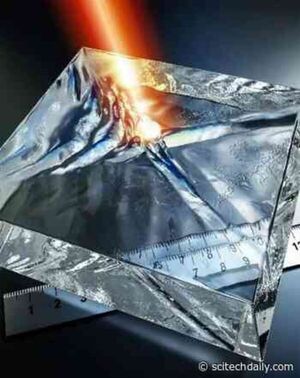
Scientists Discover a New Type of Infrared Polaritons at the Surface of Bulk Crystals
"An international team has reported in Nature the first observation of ghost polaritons, which are a new form of surface waves carrying nanoscale light strongly coupled with material oscillations and featuring highly collimated propagation properties. The research team observed these phenomena over a common material – calcite – and showed how ghost polaritons can facilitate a superior control of infrared nano-light for sensing, signal processing, energy harvesting and other technologies. In recent years, nanophotonics at infrared and terahertz frequencies has become important for highly sensitive, ultracompact and low-loss technologies for bio-molecular and chemical diagnosis, sensors, communications and other applications. Nanomaterial platforms that can facilitate enhanced light-matter interactions at these frequencies have become essential for these technologies. Recent work has been using low-dimensional van der Waals materials, such as graphene, hexagonal boron nitride and alpha-phase molybdenum trioxide (α-MoO3, Nature 2018), because of their highly exotic response to confined light at the nanoscale. However, these emerging nanomaterials require demanding nanofabrication techniques, hindering large-scale nanophotonic technologies." [...]

Research finally reveals ancient universal equation for the shape of an egg
"Researchers from Kent’s School of Biosciences, the Research Institute for Environment Treatment (Ukraine) and Vita-Market Ltd have discovered the universal mathematical formula that can describe any bird’s egg existing in nature, a feat which has been unsuccessful until now. Egg-shape has long attracted the attention of mathematicians, engineers, and biologists from an analytical point of view. The shape has been highly regarded for its evolution as large enough to incubate an embryo, small enough to exit the body in the most efficient way, not roll away once laid, is structurally sound enough to bear weight and be the beginning of life for 10,500 species that have survived since the dinosaurs. The egg has been called the “perfect shape”. Analysis of all egg shapes used four geometric figures: sphere, ellipsoid, ovoid, and pyriform (conical), with a mathematical formula for the pyriform yet to be derived. To rectify this, researchers introduced an additional function into the ovoid formula, developing a mathematical model to fit a completely novel geometric shape characterized as the last stage in the evolution of the sphere-ellipsoid, which it is applicable to any egg geometry." [...]

Quantum Emitters: Beyond Crystal Clear to Single-Photon Pure
"Photons, fundamental particles of light, are carrying these words to your eyes via the light from your computer screen or phone. Photons play a key role in the next-generation quantum information technology, such as quantum computing and communications. A quantum emitter, capable of producing a single, pure photon, is the crux of such technology but has many issues that have yet to be solved, according to KAIST researchers. A research team under Professor Yong-Hoon Cho has developed a technique that can isolate the desired quality emitter by reducing the noise surrounding the target with what they have dubbed a ‘nanoscale focus pinspot.’ They published their results on June 24 in ACS Nano. “The nanoscale focus pinspot is a structurally nondestructive technique under an extremely low dose ion beam and is generally applicable for various platforms to improve their single-photon purity while retaining the integrated photonic structures,” said lead author Yong-Hoon Cho from the Department of Physics at KAIST. To produce single photons from solid state materials, the researchers used wide-bandgap semiconductor quantum dots — fabricated nanoparticles with specialized potential properties, such as the ability to directly inject current into a small chip and to operate at room temperature for practical applications." [...]

Researchers find a way to check that quantum computers return accurate answers
"Quantum computers become ever more powerful, but how can we be sure that the answers they return are accurate? A team of physicists from Vienna, Innsbruck, Oxford, and Singapore solves this problem by letting quantum computers check each other. Quantum computers are advancing at a rapid pace and are already starting to push the limits of the world's largest supercomputers. Yet, these devices are extremely sensitive to external influences and thus prone to errors which can change the result of the computation. This is particularly challenging for quantum computations that are beyond the reach of our trusted classical computers, where we can no longer independently verify the results through simulation. "In order to take full advantage of future quantum computers for critical calculations we need a way to ensure the output is correct, even if we cannot perform the calculation in question by other means," says Chiara Greganti from the University of Vienna." [...]
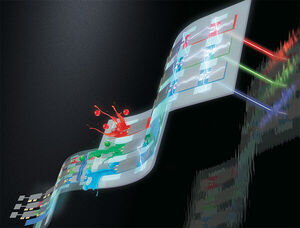
Paving the path to electrically pumped lasers from colloidal-quantum-dot solutions
"Progress overcoming a series of conceptual challenges could deliver easy-to-make lasers for medicine, research, and computing In a new review article in Nature Photonics, scientists from Los Alamos National Laboratory assess the status of research into colloidal quantum dot lasers with a focus on prospective electrically pumped devices, or laser diodes. The review analyzes the challenges for realizing lasing with electrical excitation, discusses approaches to overcome them, and surveys recent advances toward this objective. “Colloidal quantum dot lasers have tremendous potential in a range of applications, including integrated optical circuits, wearable technologies, lab-on-a-chip devices, and advanced medical imaging and diagnostics,” said Victor Klimov, a senior researcher in the Chemistry division at Los Alamos and lead author of the cover article in Nature Photonics. “These solution-processed quantum dot laser diodes present unique challenges, which we’re making good progress in overcoming.” Heeyoung Jung and Namyoung Ahn, also of Los Alamos’ Chemistry division, are coauthors. Semiconductor lasers, or laser diodes, are an essential part of many common consumer products as well as sophisticated equipment used in telecommunication, scientific research, medicine, and space exploration. Usually, these devices employ ultrathin semiconductor films, or quantum wells, grown via vacuum-based layer-by-layer atomic deposition." [...]

Generating entangled photons with nonlinear metasurfaces
"A new method for generating quantum-entangled photon pairs employs nonlinear metasurfaces to enhance and tailor photon emissions—an important step towards creating miniaturized quantum devices for everyday applications Quantum nanophotonics is an active research field with emerging applications that range from quantum computing to imaging and telecommunications. This has motivated scientists and engineers to develop sources for entangled photons that can be integrated into nano-scale photonic circuits. Practical application of nanoscale devices requires a high photon-pair generation rate, room-temperature operation, and entangled photons emitted at telecommunications wavelengths in a directional manner. The most common way to create entangled photons is by a process known as Spontaneous Parametric Down Conversion (SPDC) which involves a single photon being split into two entangled photons of lower frequencies, known as the signal and idler. Conventional approaches for SPDC rely on bulky devices that are up to several centimeters in length and are not optimal for photonic circuit integration. Conversely, at the nanoscale, the efficiency of the SPDC process is hindered by the small volume of the resonators, and the directionality of the emitted photons is challenging to control." [...]

Photovoltaic perovskites can detect neutrons
"A simple and cheap device for detecting neutrons has been developed by a team of EPFL researchers and their collaborators. The device, based on a special class of crystalline compounds called perovskites, could be used to quickly detect neutrons coming from radioactive materials, e.g. a nuclear reactor that has been damaged or that is being transported nefariously, the researchers say. The work is published in Scientific Reports. Perovskites based on organic and inorganic elements are hotly tipped to be world-beating materials for solar cell applications. But their talents don’t end with converting sunlight to power: perovskites can also be used to detect specific types of radiation, from visible light to gamma rays." [...]
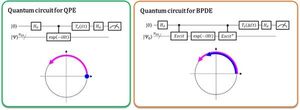
New Bayesian quantum algorithm directly calculates the energy difference of an atom and molecule
"Summary Researchers have developed a general quantum algorithm that can directly calculate the energy difference of an atom and molecule using a quantum computer. By avoiding the need to calculate the total molecular energies, the general algorithm is expected to be applied not only to quantum chemical calculations but also to various physical and mathematical problems, which are intractable with nowadays classical computers. Research outline OSAKA, Japan. As newly reported by the journal Physical Chemistry Chemical Physics, researchers from the Graduate School of Science at Osaka City University have developed a quantum algorithm that can understand the electronic states of atomic or molecular systems by directly calculating the energy difference in their relevant states. Implemented as a Bayesian phase different estimation, the algorithm breaks from convention by not focusing on the difference in total energies calculated from the pre- and post-phase evolution, but by following the evolution of the energy difference itself. “Almost all chemistry problems discuss the energy difference, not the total energy of the molecule itself,” says research lead and Specially-Appointed Lecturer Kenji Sugisaki, “also, molecules with heavy atoms that appear at the lower part of the periodic table have large total energies, but the size of the energy difference discussed in chemistry, such as electronic excitation states and ionization energies, does not depend much on the size of the molecule.” This idea led Sugisaki and his team to implementing a quantum algorithm that directly calculates energy differences instead of total energies, creating a future where scalable or practical quantum computers enable us to carry out actual chemical research and materials development." [...]

Imaginary Numbers Protect AI From Very Real Threats
"Using complex numbers helps secure machine learning algorithms from adversarial attacks in experiments focused on image classification. Computer engineers at Duke University have demonstrated that using complex numbers—numbers with both real and imaginary components—can play an integral part in securing artificial intelligence algorithms against malicious attacks that try to fool object-identifying software by subtly altering the images. By including just two complex-valued layers among hundreds if not thousands of training iterations, the technique can improve performance against such attacks without sacrificing any efficiency. The research was presented at the Proceedings of the 38th International Conference on Machine Learning. “We’re already seeing machine learning algorithms being put to use in the real world that are making real decisions in areas like vehicle autonomy and facial recognition,” said Eric Yeats, a doctoral student working in the laboratory of Helen Li, the Clare Boothe Luce Professor of Electrical and Computer Engineering at Duke. “We need to think of ways to ensure that these algorithms are reliable to make sure they can’t cause any problems or hurt anyone.” One way that machine learning algorithms built to identify objects and images can be fooled is through adversarial attacks." [...]
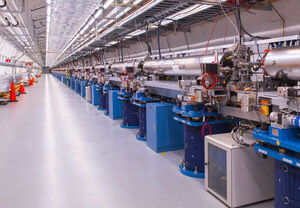
Understanding how electrons drive chemical reactions
"An Imperial-led team of international researchers has used a special X-ray probe to gain new insights into how electrons behave at the quantum level. Since electrons drive many chemical reactions, the method could lead to a deeper understanding of physics, chemistry and life sciences and could ultimately help design advanced materials and more efficient solar cells. The team includes researchers from across Europe, the US and Japan – led by Imperial’s Professor Jon Marangos, Lockyer Chair in Physics. Their paper is published in the open-source journal Physical Review X. The importance of photoexcitation The classic picture of an atom, as taught in schools around the world, envisions a central nucleus of protons and neutrons packed tightly together, around which electrons orbit like planets around the sun. And like planets, the electrons have different orbits, some close to the centre, some further away, depending on their energy levels." [...]

U of T researchers develop new quantum 'fingerprinting' protocol to improve information exchange
"Suppose you and your cousin are about to inherit some money and you each have a version of the will on your computer. What is the least amount of information your computers must share to determine whether the versions are the same? This hypothetical scenario raises a communication complexity problem. These problems deal with how much information you need to exchange – from computer to computer, or from network node to node – to perform a certain task or function. The less information transmitted to complete the task, the more energy and time saved – and the more privacy is preserved. Li Qian and Hoi-Kwong Lo, both professors in the University of Toronto's Edward S. Rogers Sr. department of electrical and computer engineering in the Faculty of Applied Science & Engineering, and Xiaoqing Zhong, a PhD candidate in the department of physics in the Faculty of Arts & Science, have developed an improved quantum fingerprinting (QF) protocol to more efficiently and securely solve these types of problems, which come up in contexts such as computer networking and Very Large Scale Integration (VLSI) chip design, among other situations." [...]
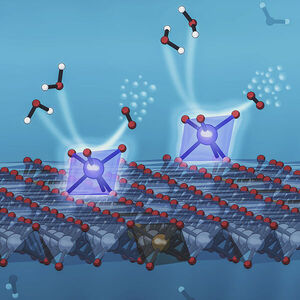
A new approach creates an exceptional single-atom catalyst for water splitting
"Anchoring individual iridium atoms on the surface of a catalytic particle boosted its performance in carrying out a reaction that’s been a bottleneck for sustainable energy production. A new way of anchoring individual iridium atoms to the surface of a catalyst increased its efficiency in splitting water molecules to record levels, scientists from the Department of Energy’s SLAC National Accelerator Laboratory and Stanford University reported today. It was the first time this approach had been applied to the oxygen evolution reaction, or OER –part of a process called electrolysis that uses electricity to split water into hydrogen and oxygen. If powered by renewable energy sources, electrolysis could produce fuels and chemical feedstocks more sustainably and reduce the use of fossil fuels. But the sluggish pace of OER has been a bottleneck to improving its efficiency so it can compete in the open market. The results of this study could ease the bottleneck and open new avenues to observing and understanding how these single-atom catalytic centers operate under realistic working conditions, the research team said." [...]
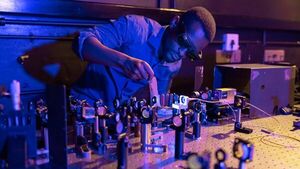
Are you quantum or not? Wits PhD student cracks the high-dimensional quantum code
"A new and fast tool for quantum computing and communication. Isaac Nape, an emerging South African talent in the study of quantum optics, is part of a crack team of Wits physicists who led an international study that revealed the hidden structures of quantum entangled states. The study was published in the renowned scientific journal, Nature Communications, on Friday, 27 August 2021. Nape is pursuing his PhD at Wits University and focuses on harnessing structured patterns of light for high dimensional information encoding and decoding for use in quantum communication. Earlier this year he scooped up two awards at the South African Institute of Physics (SAIP) conference to add to his growing collection of accolades in the field of optics and photonics. He won the award for ‘Best PhD oral presentation in applied physics’, and jointly won the award for ‘Best PhD oral presentation in photonics’." [...]

New Mathematical Solutions to An Old Problem in Astronomy
"The Bernese theoretical astrophysicist Kevin Heng has achieved a rare feat: On paper, he has derived novel solutions to an old mathematical problem needed to calculate light reflections from planets and moons. Now, data can be interpreted in a simple way to understand planetary atmospheres, for example. The new formulae will likely be incorporated into future textbooks. For millennia, humanity has observed the changing phases of the Moon. The rise and fall of sunlight reflected off the Moon, as it presents its different faces to us, is known as a "phase curve". Measuring phase curves of the Moon and Solar System planets is an ancient branch of astronomy that goes back at least a century." [...]
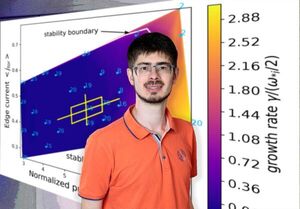
Updated state-of-the-art computer code could advance efforts to harness fusion energy on Earth
"Think of light bulb filaments that glow when you flip a switch. That glow also occurs in magnetic fusion(link is external) facilities known as tokamaks(link is external) that are designed to harness the energy that powers the sun and stars. Understanding how resistivity, the process that produces the glow, affects these devices could help scientists design them to operate more efficiently. Researchers at the U.S. Department of Energy’s (DOE) Princeton Plasma Physics Laboratory (PPPL) have used supercomputers and a state-of-the-art computer code to simulate plasma in fusion devices under a wider range of conditions than ever before. This new capability helps researchers predict when the plasma should be calm and when it should exhibit occasional bursts of energy from the plasma’s edge known as edge-localized modes (ELMs). The new simulations unexpectedly revealed that whether these bursts occur can be strongly influenced by the plasma’s resistivity, the property of a material that obstructs the flow of electric current." [...]

Geologists propose theory about a famous asteroid
"The troughs on Vesta have long been a topic of scientific speculation The asteroid Vesta is the second largest asteroid in our solar system. With a diameter of about 330 miles, it orbits the sun between the planets Mars and Jupiter. Asteroids have long played a part in building popular fascination with space. “Marooned off Vesta” was the first story published by American writer Isaac Asimov, the third story he wrote, appearing in the March 1939 issue of the science fiction magazine Amazing Stories. “When we think of asteroid belts, we probably picture Han Solo maneuvering the millennium falcon through a dense set of irregularly shaped gray rocks in space,” Christian Klimczak, associate professor in the Franklin College of Arts and Sciences department of geology. “While most rocks are indeed irregularly shaped and gray, they are far apart and NASA’s Dawn spacecraft did not have to maneuver around any other asteroids to reach and explore Vesta.” Dawn was the space probe launched by NASA in September 2007 with the mission of studying two of the three known protoplanets of the asteroid belt, Vesta and Ceres." [...]

Ferroelectrics everywhere?
"New family of ferroelectric materials raises possibilities for improved information and energy storage A new family of materials that could result in improved digital information storage and uses less energy may be possible thanks to a team of Penn State researchers who demonstrated ferroelectricity in magnesium-substituted zinc oxide. Ferroelectric materials are spontaneous electricly polarized bcause negative and positive charges in the material tend toward opposite sides and with the application of an external electric field reorient. They can be affected by physical force, which is why they are useful for push-button ignitors such as those found in gas grills. They can also be used for data storage and memory, because they remain in one polarized state without additional power and so are low-energy digital storage solutions. "We've identified a new family of materials from which we can make tiny capacitors and we can set their polarization orientation so that their surface charge is either plus or minus,” said Jon-Paul Maria, professor of materials science and engineering, and co-author of the paper published in the Journal of Applied Physics. "That setting is nonvolatile, meaning we can set the capacitor to plus, and it stays plus, we can set it to minus, it stays minus." [...]

360-degree transparency for construction sites made simple
"Jeevan Kalanithi SM ’07 is CEO of OpenSpace, a company founded by three Media Lab graduates using computer vision to benefit the construction industry. MIT spinoff OpenSpace invented automated 360-degree video jobsite capture and mapping. “It’s not exactly an amazing observation,” says CEO Jeevan Kalanithi, “but a picture really is worth a thousand words.” In the world of real estate development, visual documentation of construction projects is critical. It aids in dispute resolution, prevents mistakes from being compounded, and allows for knowledge capture in case of change orders. Builders are often contractually obligated to document progress. Usually, this means hiring someone to walk the site and take photos of key areas once a month." [...]
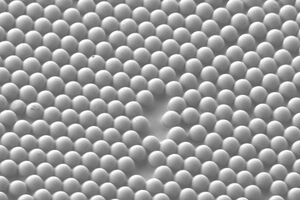
This rainbow-making tech could help autonomous vehicles read signs
"A study explains the physics behind reflective microscale concave interfaces — structures that reflect light in fascinating ways. A new study explains the science behind microscale concave interfaces (MCI) — structures that reflect light to produce beautiful and potentially useful optical phenomena. “It is vital to be able to explain how a technology works to someone before you attempt to adopt it. Our new paper defines how light interacts with microscale concave interfaces,” says University at Buffalo engineering researcher Qiaoqiang Gan, noting that future applications of these effects could include aiding autonomous vehicles in recognizing traffic signs. The research was published online on Aug. 15 in Applied Materials Today, and is featured in the journal’s September issue. Gan, PhD, professor of electrical engineering in the UB School of Engineering and Applied Sciences, led the collaborative study, which was conducted by a team from UB, the University of Shanghai for Science and Technology, Fudan University, Texas Tech University and Hubei University." [...]

An Accidental Discovery Hints at a Hidden Population of Cosmic Objects
"Brown dwarfs aren’t quite stars and aren’t quite planets, and a new study suggests there might be more of them lurking in our galaxy than scientists previously thought. A new study offers a tantalizing explanation for how a peculiar cosmic object called WISEA J153429.75-104303.3 – nicknamed “The Accident” – came to be. The Accident is a brown dwarf. Though they form like stars, these objects don’t have enough mass to kickstart nuclear fusion, the process that causes stars to shine. And while brown dwarfs sometimes defy characterization, astronomers have a good grasp on their general characteristics. Or they did, until they found this one." [...]

OSU cryptography research leads to huge efficiency gain in secure computing
"Oregon State University researchers have developed a secure computation protocol that’s 25% more efficient than what had been thought the best possible, meaning future savings in time and energy costs for groups needing to team up on computations while keeping their individual data private. Mike Rosulek, associate professor of computer science in the OSU College of Engineering, and graduate student Lance Roy presented their findings at this month’s virtual 41st annual International Cryptology Conference, or Crytpo 2021. The conference is organized by the International Association for Cryptologic Research. Roy, a 22-year-old who grew up in Corvallis, entered Oregon State’s computer science Ph.D. program at 18, going directly from homeschool high school to the OSU Graduate School. He had begun auditing undergraduate courses at OSU at age 12. Secure computation is often explained via “Yao’s millionaire problem,” a hypothetical situation developed by and named after computer scientist and computational theorist Andrew Yao in which two wealthy people want to determine who is richer but neither wants to reveal to the other how much money she/he has." [...]

Who can bend light for cheaper Internet?
"Wide Area Networks (WANs), the global backbones and workhorses of today’s Internet that connect billions of computers over continents and oceans, are the foundation of modern online services. As COVID-19 has placed a vital reliance on online services, today's networks are struggling to deliver high bandwidth and availability imposed by emerging workloads related to machine learning, video calls, and health care. To connect WANs over hundreds of miles, fiber optic cables that transmit data using light are threaded throughout our neighborhoods, made of incredibly thin strands of glass or plastic known as optical fibers. While they’re extremely fast, they’re not always reliable: they can easily break from weather, thunder storms, accidents, and even animals. These tears can cause severe and expensive damage, resulting in 911 service outages, lost connectivity to the Internet, and inability to use smartphone apps. Scientists from MIT’s Computer Science and Artificial Intelligence Laboratory (CSAIL) recently came up with a way to preserve the network when the fiber is down and reduce cost." [...]
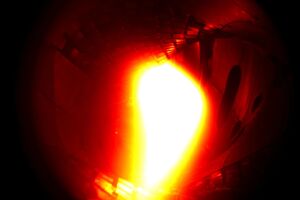
Wendelstein 7-X fusion reactor on path to plasma twice as hot as the Sun
"The Wendelstein 7-X stellarator is an experimental nuclear fusion reactor designed to bring us closer to the prospect of clean, limitless energy, and since producing its first plasma in 2015 we've seen it take steady and significant steps toward that aim. Physicists have just confirmed another "major advance" that could see the reactor host plasma twice as hot as the Sun's core as a result of efforts to address inherent energy losses in the design. Stellarators stand apart from the more common, symmetrical doughnut-shaped tokamak fusion reactors as hugely complex structures full of twists and turns. As it is with all nuclear fusion reactors, the goal is to recreate the processes at play within the Sun, by subjecting streams of plasma to extreme temperature and pressure, forcing atoms to collide and fuse together to produce monumental amounts of energy. The Wendelstein 7-X reactor is so complex it required supercomputers to design. It uses a series of 50 superconductive magnetic coils to hold in place plasma as it loops around a twisting and turning circular chamber." [...]

Synthetic biology enables microbes to build synthetic muscle
"Would you wear clothing made of muscle fibers? Use them to tie your shoes or even wear them as a belt? It may sound a bit odd, but if those fibers could endure more energy before breaking than cotton, silk, nylon, or even Kevlar, then why not? Don’t worry, this muscle could be produced without harming a single animal. Researchers at the McKelvey School of Engineering at Washington University in St. Louis have developed a synthetic chemistry approach to polymerize proteins inside of engineered microbes. This enabled the microbes to produce the high molecular weight muscle protein, titin, which was then spun into fibers." [...]
Projetos Maker
Diversos Projetos interessantes.
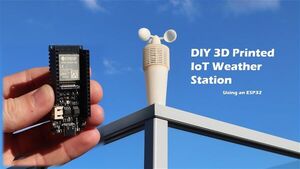
DIY 3D Printed IoT Weather Station Using an ESP32
"Today we’re going to be building a wireless outdoor weather station that takes temperature, humidity, barometric pressure, light and wind speed readings. The data is then posted to the cloud and can be accessed through a Thingspeak dashboard on an internet-connected computer, tablet, or mobile phone. I’m going to use a development board from DF Robot called a Firebeetle ESP32-E IoT. I’ve chosen this particular board because it is inherently designed for low-power applications and can be powered by a lithium-ion battery directly. It’s got an onboard battery plug and supports charging through the USB C port. For the sensors, I’m going to be using grove sensors by Seeed Studios." [...]
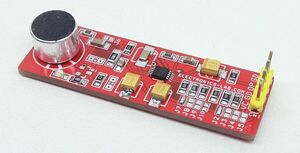
Low Voltage Microphone Preamplifier with Variable Compression and Noise-Canceling
"This is a complete microphone signal conditioning project. Designed primarily for voice-band applications, this project provides amplification, limiting, variable compression, and noise gate. User-adjustable compression ratio, noise gate threshold, and two different fixed gains optimize circuit operation for a variety of applications. This is a complete and flexible solution for conditioning condenser microphones for personal electronics and computer audio systems. It is also excellent for improving vocal clarity in communications and the public address systems. A low noise voltage-controlled amplifier (VCA) provides a gain that is dynamically adjusted by a control loop to maintain a set compressions characteristic." [...]
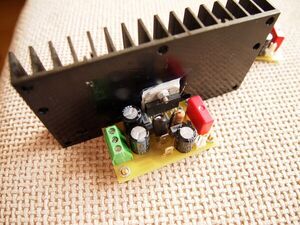
50W Power Amplifier with LM3886
"This is my second encounter with LM3886. I was pleased with the sound this chip produced the first time, so I decided to make another amplifier with it. The schematic is based on the schematic in the datasheet of the chip with minor changes. I removed the time delay capacitor connected to MUTE pin, because it’s better to use separate DC protection schematic which has similar functionality. I made the output inductance L1 by winding 15 turns of enameled wire around the resistor R7. The diameter of the wire must be minimum 0.4mm." [...]

IR Remote Controlled Motorized Potentiometer – Arduino Compatible
"This is an Infrared Remote controlled motorized potentiometer controller. It’s an open-source project built on the Arduino platform and compatible with Arduino IDE for custom programming. The project consists ATMEGA328 microcontroller, IR sensor, L293D motor driver, ALPS Motorized potentiometer, a connector for Arduino programming, etc. The L293D H-bridge drives the potentiometer motor, 2 Parallel direction pins are used to change the motor direction which moves the POT in a forward or reverse direction. " [...]
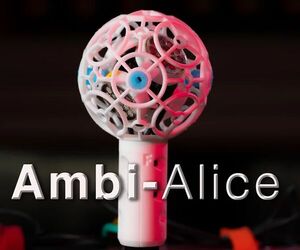
Ambi-Alice a First Order Ambisonic Microphone
"An Ambisonic Microphone records audio in multiple directions allowing you to change the direction of where you are listening after recording, sometimes while you are listening. There are several of these on the market but we are going to build our own. Construction uses a 3D printed housing, very good mic capsules and deceptively simple electronics. You can choose two mounting methods, one will mount on a traditional mic strand using a mic clip. The second integrates a -20 bolt into the housing allowing you to use alternative mountings such as GoPro mounts and Cold Shoe camera mounts. Both have a great eco system of options." [...]

Raspberry Pi Force Gauge and Weight Scale Using Hexabitz
"Learn how to build a digital weight scale and force gauge with load cell sensor (H26R0x) and Raspberry Pi. This project uses Hexabitz modules to measuring the boxing punch force. It’s definitely an effective way to learn about load cell sensor, Raspberry Pi interface module & Hexabitz development C++ library. The force of an object is a product of that object's acceleration and mass. English physicist Isaac Newton introduced this fundamental identity of classical mechanics with his second law of motion, F = ma. F represents force; m represents mass; and the variable a represents acceleration." [...]

ESP32 Node
"The ESP32 Node is a development board for Wireless Sensor Network based on WiFi. It uses the ESP32WROOM3E module from Espressif Systems. Applications - Connect a Temperature Humidity sensor to monitor the Weather/Room abience - Use it to control relays and turn on/off your lights, fan, etc. - Run ML applications using edge impulse or tensor flow lite. " [...]
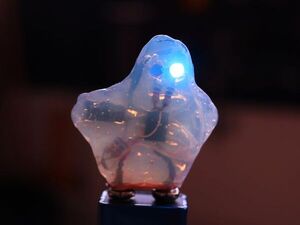
Electronic Ghost
"This spooky electronic ghost is a 555 LED flasher circuit encapsulated in silicone rubber. " [...]
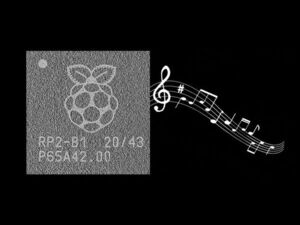
MP3 Playback on RP2040 with CircuitPython
"Compressed audio can be a nice alternative to uncompressed WAV files, especially when you have a small filesystem like that on many CircuitPython boards, as WAV files get sizeable quite quickly. You can listen to a much longer playlist with CircuitPython, using the built in MP3 playback capability! CircuitPython supports any MP3 file, as long as it is the right bit rate and sample rate for your board. Mono and stereo files less than 64kbit/s work, with sample rates from 8kHz to 24kHz. The RP2040 has a PWM output with 10 bits, so there's not much point in using high bit rates. Be aware, doing things like updating a display, or having intense flash activity like reading and writing files can result in distorted sounds or noise during playback." [...]

Chordie
"This is my attempt at a chording keyboard. I got inspired by gBoards' Ginny keyboard but felt like there's some room for improvements. Especially uncomfortable was using mouse with it. Thus I have decided to attach a trackball. Now mouse buttons are part of the keyboard and can also be usen in chords. Trackball can be kept very close to the keyboard eliminating the need for moving your hand like with normal mouse." [...]

Laser Engraving With DIY Arduino Scara Robot
"In this tutorial I will show you how I converted my DIY 3D Printed SCARA robot arm that I built in one of my previous videos to work as a laser engraver. You can watch the video following video or read the article below. Project Overview The SCARA robot has 4 degrees of freedom which are driven by 4 NEMA 17 stepper motors and controlled using an Arduino board. In the original video I used an Arduino UNO board in combination with a CNC Shield, but now we will use an Arduino MEGA board in combination with a RAMPs board. We need this combination because we will use the Marlin 3D Printer firmware for controlling the robot. As for the mechanical part, I just had to change the gripper mechanism with a laser module." [...]
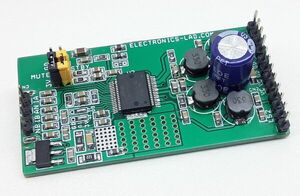
5 W + 5 W Dual BTL Class-D Audio Amplifier
"The project described here is a high-efficiency dual BTL class-D audio amplifier with single supply operations. The project was built using TDA7491LP13TR from ST. The low profile PCB design can fit in a small area, operating power supply 9-12V DC, Project supports single-ended or differential audio signal inputs. Jumpers are provided to set the various gains, standby, and mute functions. KEY FEATURES - 5W + 5W Continuous Output Power, 10% THD, (8 Ohms Speaker) at 9V DC - Single Supply Operation 9V to 12V - Four Selectable Fixed Gains Settings of nominally 20dB, 26dB, 30dB, 32dB Using Jumpers - Differential Inputs Minimize Common-Mode Noise - Jumper for Single-Ended Inputs - No “Pop” Sound at Turn-On/Off - Thermal Over Load Protection - Standby and Mute Features Using Jumpers - PCB Dimensions 63.25 x 32.39 mm" [...]

PicoROM
"Speed up retro computer development with a 400 MHz Raspberry Pi Pico-based ROM emulator. PicoROM emulates ROM chips to allow for rapid development of retro computer software. Rather than remove the ROM IC, burn new contents, and replace the chip for each iteration, PicoROM makes it possible to simply drag-and-drop new code, without even turning the retro computer off. I'm using it to emulate an Atmel 28C256 32KB EEPROM, but it should be compatible with many other similar chips without modification. I previously built a similar device, RapidROM, with an FPGA. While this solution works great, I've heard from a lot of people that wanted to modify it to work with different ROM chips, but found it too difficult because of an unfamiliarity with Verilog or FPGAs." [...]
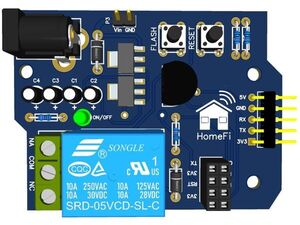
ESP8266 ESP-01 with a shield programmer
"You will learn how to create your own shield to create automation projects and to program your own ESP8266 ESP01. The ESP8266 ESP-01 is a great device for creating automation & electronics projects with the Internet of Things. In this article, you will get 5 free samples of this board and learn how to build the complete schematic of the electronic project. " [...]
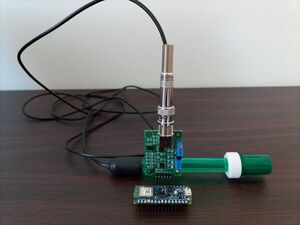
Water pH Monitoring for Hydroponic Plant
"Sense the water pH of a hydroponic plant with Arduino Nano 33 BLE Sense and determine if it's right using an Edge Impulse trained model. Introduction I’ve had a hydroponic plant for two years now, and everything went well until this summer. The new flowers, that were supposed to be pink, were green with a few shades of pink. So I searched on Google and I found out that the optimal water pH value for my plant is from 5.5 and 5.8. Well, guess what? I was using tap water for the plant and its pH is 7!" [...]

Programmable PCB Conference Card
"Why wear a boring paper card to a conference when you can bring a cool and hackable one based on an ATtiny85? Programmable cards and badges are really good ice breakers at conferences as they're a great way to showcase your interests and skills. Packed with features and easter eggs, hackable PCB cards and badges have become customary to bring to the PCB Design conventions and hackathons now a days. This project features a simple PCB Card just to give you an idea of what's possible and how easy it is to get started with your own PCB Card. I created this project using Inventhub, as it provides a git based version control, visual diffing of PCB and Schematic designs and a convenient library manager, all in one platform. " [...]
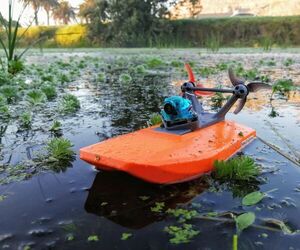
Micro FPV Boat From Drone Parts
"Introduction If you are anything like me then you have an ever-growing collection of damaged drone parts. Sometimes those parts accumulate back into a drone, but there are always a few leftovers… The goal of this project was to use up some extra parts and build something fun. Because we will only use two motors you can easily repurpose an FC with a damaged ESC (In my case a BeeBrainBL Flight Controller that someone accidentally crashed into water one too many times, which I found gloriously ironic). This is a good time to mention that this whole project is ill-advised, water and electronics don’t mix, don’t try this at home (or do, but don't blame me when you fry something 😉) Although I am rather pleased with my final iteration, I would like to take you through the process that got us there, since I think the fails are fun, and certainly great learning opportunities to see what makes an airboat sink or swim. Feel free to skip the first few steps if you just want to build the end result (it starts at step 5), or just enjoy the video summary below! Components Used I have specifically designed this project to use the leftovers from dead micro drones, so use what you have." [...]

CRISS CP/M 8-bit Homebrew DIY Computer (AVR based)
"the FIRST single-board DIY 8-bit personal computer with VGA, Ethernet and printer support, GPIO and CP/M powered! Meet my CRISS CP/M: the modern single-board 8-bit full-featured personal computer! Amazing functionality for the DIY device: it is not a toy, it is REAL Computer, the SAFEST computer in the world and the sophisticated control platform for your projects! Features: OS: CP/M 2.2 = programming languages, text processors, games, business software, ... Instructions: Z80 (Zilog), extended with MUL, DIV, and floating-point, 1us LD r,r ops Memory: 64Kb SRAM, 128 Kb EPROM Video: VGA (! ), monochrome, up to 25x80 chars, 5 symbols sets, graphic 160x96 px Storage: SD-card Keyboard: standard PS/2 Printer: YES, serial or LPT Interfaces: RS-232, UART, Ethernet, GPIO, CAN (option) Real time clock with battery Single-tone melody generator with built-in speaker Hardware emulation: Robotron 1715, Kaypro, Microbee, TRS-80, ... 8-bit Microchip AVR MCUs based, DIP components only (!" [...]

Sensitive Arduino Lightning Detector with Homemade Sensor
"How to make a sensitive homemade lightning detector based on cheap AM receiver IC TA7642 and Arduino Nano. A lightning detector is a device that detects lightning produced by thunderstorms. In one of my previous videos, I showed you how to make such a detector with the help of the AS3935 sensor board which is specially designed for this purpose. This time I will show you how to make same such device, but now with a homemade detector circuit based on cheap AM Receiver IC TA7642. This design is many times cheaper, its sensitivity is much higher, and Also the resistance to local disturbances as various sparks from electrical devices is very high. The ingenious idea of using AM receiver IC as a detector is presented on elektronik-labor.de page under the name "The Franzis thunderstorm warner"." [...]
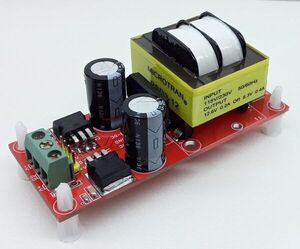
Dual +5 V/-5V @ 200 mA Regulated Linear Power Supply
"The project presented here is a dual AC to DC output linear power supply. This power supply provides low ripple low noise DC regulated output. Usually, transformer-based linear power supplies are considered very bulky and inefficient, but this power supply still is very important for sensitive applications such as analog circuits, communications devices, radio devices, audio circuits, OPAMP-based projects etc. " [...]
Secção Videos
Videos interessantes.
That's all Folks!







